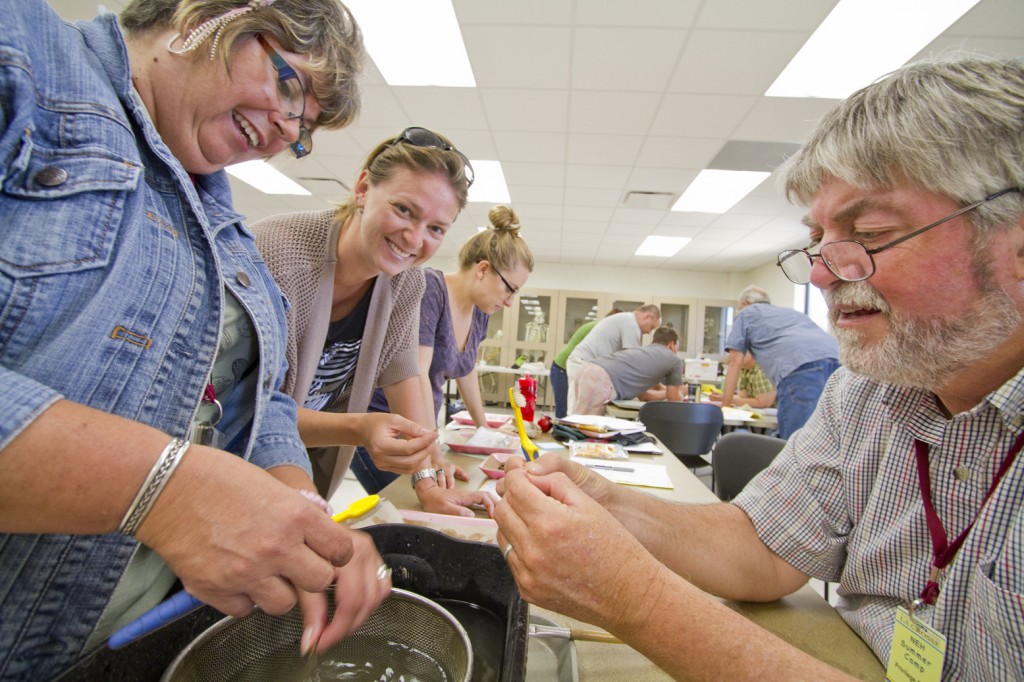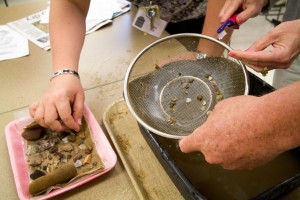Posted 2:52 p.m. Friday, July 20, 2012

 [/caption]
Many of Miranda Meyerson’s students have never been outside the expansive city limits of Brooklyn, N.Y. When they have questions about American history, conceptualizing what this country once was and how it came to be can be confusing.
“How do we know things from the past? My answer is always, ‘Because it says in the book.’ And that’s not a very good answer,” says Meyerson.
A National Endowment for Humanities Summer Institute for Teachers at UW-L is helping Meyerson and 24 other K-12 teachers from throughout the country answer questions like these about the past. UW-L is one of just 14 sites across the nation to earn a prestigious $150,000 NEH grant to host the teachers.
During the institute, July 9-27, teachers participate in an archaeological dig, clean artifacts and visit destinations ranging from an Amish farm to Effigy Mounds National Monument. Through these activities and more, they learn how people living in the Upper Mississippi River Valley have changed and adapted from the end of the ice age to the Amish and organic farmers of today.
[caption id="attachment_13518" align="alignright" width="300" caption="Teachers learned how these artifacts they uncovered can help them teach about the past. “Learning more about your own backyard is humbling because you think you know where you live. I had no clue,” Marty Momsen, a teacher from Fountain City."]
[/caption]
Many of Miranda Meyerson’s students have never been outside the expansive city limits of Brooklyn, N.Y. When they have questions about American history, conceptualizing what this country once was and how it came to be can be confusing.
“How do we know things from the past? My answer is always, ‘Because it says in the book.’ And that’s not a very good answer,” says Meyerson.
A National Endowment for Humanities Summer Institute for Teachers at UW-L is helping Meyerson and 24 other K-12 teachers from throughout the country answer questions like these about the past. UW-L is one of just 14 sites across the nation to earn a prestigious $150,000 NEH grant to host the teachers.
During the institute, July 9-27, teachers participate in an archaeological dig, clean artifacts and visit destinations ranging from an Amish farm to Effigy Mounds National Monument. Through these activities and more, they learn how people living in the Upper Mississippi River Valley have changed and adapted from the end of the ice age to the Amish and organic farmers of today.
[caption id="attachment_13518" align="alignright" width="300" caption="Teachers learned how these artifacts they uncovered can help them teach about the past. “Learning more about your own backyard is humbling because you think you know where you live. I had no clue,” Marty Momsen, a teacher from Fountain City."] [/caption]“My students think that when their European ancestors came it was untouched,” says Marty Momsen, who teaches 7th, 8 and 10th grade in the Cochrane-Fountain City, Wis., School District. “That’s not the case.”
During a one-day excavation on a property near Newton, Wis., teachers found clues about the region’s earliest settlers. Katina Smith, who teaches middle school science in Rye, N.Y., and her group found 75 artifacts, including pieces of rock left over from making stone tools, pottery and charcoal — all in a 2 x 2 meter work area.
“It’s been hot, sweaty, dirty and dusty, but exciting,” notes Smith. “The highlight is working with other teachers and networking with them to see how they approach teaching these topics in creative ways.”
As Meyerson gently scrubs an artifact clean with a toothbrush, she explains how these pieces are clues to put together the picture of a civilization. She plans to share those clues with her class back in Brooklyn. It will allow her students to see how they could examine a culture beyond the book.
“The whole experience is refreshing,” says Meyerson. “You feel excited to go back and teach.”
UW-L archaeologists who lead the institute also benefit.
“It’s a pleasure to work with these teachers. They keep you on your toes,” says Bonnie Jancik, UW-L’s Mississippi Valley Archaegology Center director of public education. “We are so grateful to NEH for giving us this opportunity to provide professional development for teachers.”
[/caption]“My students think that when their European ancestors came it was untouched,” says Marty Momsen, who teaches 7th, 8 and 10th grade in the Cochrane-Fountain City, Wis., School District. “That’s not the case.”
During a one-day excavation on a property near Newton, Wis., teachers found clues about the region’s earliest settlers. Katina Smith, who teaches middle school science in Rye, N.Y., and her group found 75 artifacts, including pieces of rock left over from making stone tools, pottery and charcoal — all in a 2 x 2 meter work area.
“It’s been hot, sweaty, dirty and dusty, but exciting,” notes Smith. “The highlight is working with other teachers and networking with them to see how they approach teaching these topics in creative ways.”
As Meyerson gently scrubs an artifact clean with a toothbrush, she explains how these pieces are clues to put together the picture of a civilization. She plans to share those clues with her class back in Brooklyn. It will allow her students to see how they could examine a culture beyond the book.
“The whole experience is refreshing,” says Meyerson. “You feel excited to go back and teach.”
UW-L archaeologists who lead the institute also benefit.
“It’s a pleasure to work with these teachers. They keep you on your toes,” says Bonnie Jancik, UW-L’s Mississippi Valley Archaegology Center director of public education. “We are so grateful to NEH for giving us this opportunity to provide professional development for teachers.”
